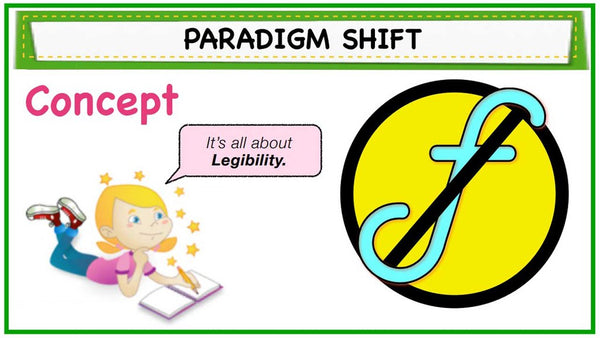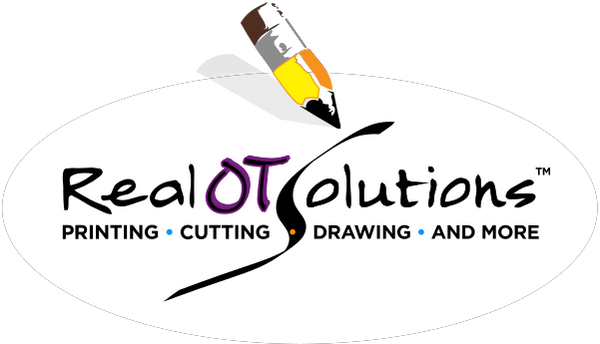
Basically, we teach a very simple look to letters.
- Nothing stylized.
- Nothing script-like.
In fact, if your schools have already invested in D’Nealian, Zaner-Bloser, Peterson, Fundations, and even Handwriting Without Tears, you can still use their font. Just overlay the Size Matters® concepts on top. The concepts, especially the Rules complement and supplement all existing curriculum… because the goal is LEGIBILITY.
Size Matters® is after all, also a full curriculum and is therefore sufficient by itself. But because we are just as excited as you to have any school district still interested in teaching handwriting, the last thing we want to tell them is that they’re doing it wrong! Let’s support the fact that they are doing it at all, and then simply show them a way to do it better.
That lends an extra qualifying layer to the merits of Size Matters®. It can complement or supplement any existing program.
If the current programs have workbooks, desktop strips, verbal prompts or even specialized writing paper… start with that. In time, you will layer the Key Concepts throughout your lessons. In time, you may find you don’t need two different programs.
SMHP is a PROACTIVE approach.
It is designed for today’s schools where the demand for accountability has never been greater. We’ve already discussed how teachers are struggling to cover content, measure growth and intervene at the earliest time possible. This program provides data as you go along.
It anticipates cutbacks in funding. If sports teams, guidance counselors, the arts and classroom aides are on the chopping block, purchases of consumable workbooks are, too. And it embeds handwriting into the curriculum—the only way to get true carryover anyway. Yes, as you’ll learn in Part 2, handwriting sensibility can be easily infused into all subject matter at all times of the day. Not just the 20 minutes of traditional instruction time. Because of these qualities, we consider it leading edge and forward thinking.
It’s also FISCALLY RESPONSIBLE.
With only one consumable workbook, (and that’s a Kindergarten level book because I think it’s helpful for Kindergartners or beginner printers to have a reference), it is already a yearly cost-saver. And just as an aside, I should tell you that the book doesn’t say ‘Kindergarten’, for any older students, special education students or anyone else in need of working on one letter at a time.
Preschoolers too have a reference. Consistent with our efforts to be green and fiscally responsible, the Letterbox Worksheets are re-usable wipe-off books. All other grades use materials that are approved for copying. In fact, the Adapted Writing Paper Master Guide is designed to be copied. Plus, other supportive materials can be reused from year to year. Laminate your Posters. Use Dry Erase markers and erasers on the Magnetic Rectasquare Boards. Wipe down the Alphatrangles®. These and more are just some of the materials that are one-time purchases.
FLEXIBLE and ADAPTABLE…
Yep… the Size Matters® Handwriting Program can be used in a variety of settings:
- As a Push-in Collaborative Model. This is Best Practices for a number of reasons. First… the setting is the least restrictive environment. Once students are pulled from their classrooms, you have removed them from their peers and their teacher. Push-in allows us to model language and strategies that teachers can employ all day, every day, throughout the day.
- As a Pullout Therapeutic Intervention. Pullout happens. Sometimes it is a concession to a parent. Sometimes a child’s needs are so great that they cannot be addressed in the classroom. Pullout is more of a medical model. In schools mandating direct services for billing or other reasons, it’s good to know that SMHP can be super effective for students with multiple and complex issues.
- As a stand-alone Curriculum. Lesson Plans in the Teacher Manual identify the objectives, materials, accommodations, extension activities and all the answers to the 10 different Learning Activities on each page of the Student Workbook.
- As a Center Time activity. Centers are a fun time to play with the concepts and make some of the supportive materials. Manipulatives that build letters or graph words work simultaneously to reinforce language, vocabulary and terms from all content areas.
- As a Handwriting Club. Clubs can be structured before, during or after school. Structured well, these are popular go-to activities. Best of all… students become the teachers. Great time to build peer mentors. Kids teaching kids? Best Practice!!
- As a Home Program. So many of the materials are easy and fun to use, features that appeal to parents who want to help.
- In Response to Intervention, Multi-tiered Student Support or Intervention and Remediation Services (i.e. RtI, MTSS or I&RS). Whatever early intervening acronym is used by your school, the common denominator is measurable, tiered, evidence-based application equally in large or small groups, schoolwide or individual. Got it!!

